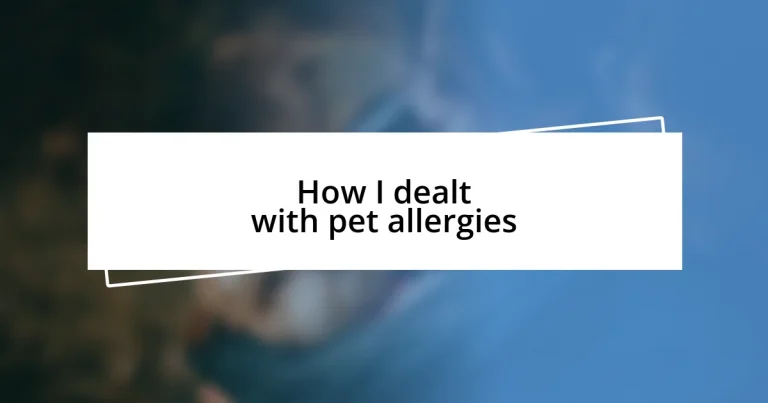Key takeaways:
- Pet allergies are commonly triggered by proteins in saliva, urine, or dander, which can lead to frustrating symptoms like sneezing and itchy eyes.
- Effective management strategies include installing air purifiers, establishing pet-free zones, and maintaining regular cleaning routines to minimize allergens.
- Medication options, such as antihistamines and nasal corticosteroids, can significantly alleviate allergy symptoms for better comfort.
- Exploring hypoallergenic pet breeds and fostering or pet-sharing arrangements can provide companionship while managing allergic reactions.
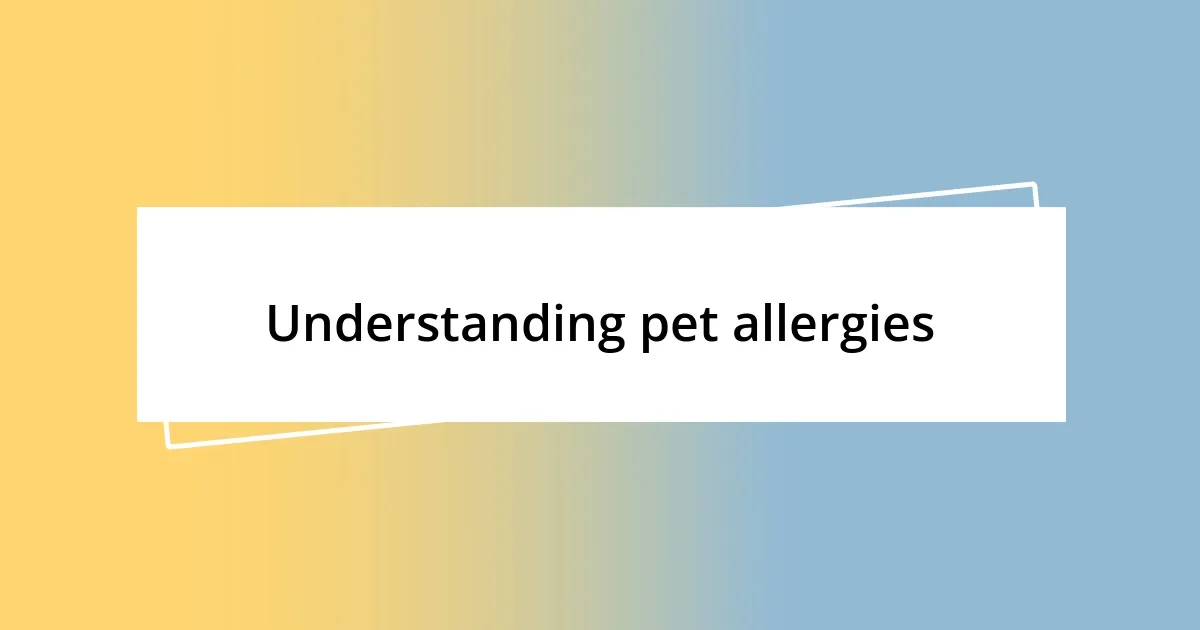
Understanding pet allergies
Pet allergies can be quite a challenge. I remember the first time I realized I was allergic to my cat, Whiskers. It felt like a betrayal, since I loved having her around. The sneezing, itching, and constant runny nose caught me completely off guard. Have you ever experienced that sinking feeling when something you adore becomes a source of discomfort?
These allergies are typically triggered by proteins found in pet saliva, skin, or urine, which float around in the air and settle on surfaces. I found it fascinating (and a bit alarming) to learn that it’s not just fur that can cause the problem; it’s those microscopic particles that can really wreak havoc on your immune system. It made me wonder, what else might I be unknowingly allergic to in my home?
Understanding that pet allergies are so common can be comforting. I came to realize that I’m not alone; many people struggle with this issue while wanting to keep their furry companions close. I often thought about how many times I’d had to choose between enjoying Whiskers’ company and dealing with the frustrating symptoms. It’s a delicate balance that requires awareness and adaptation, don’t you think?
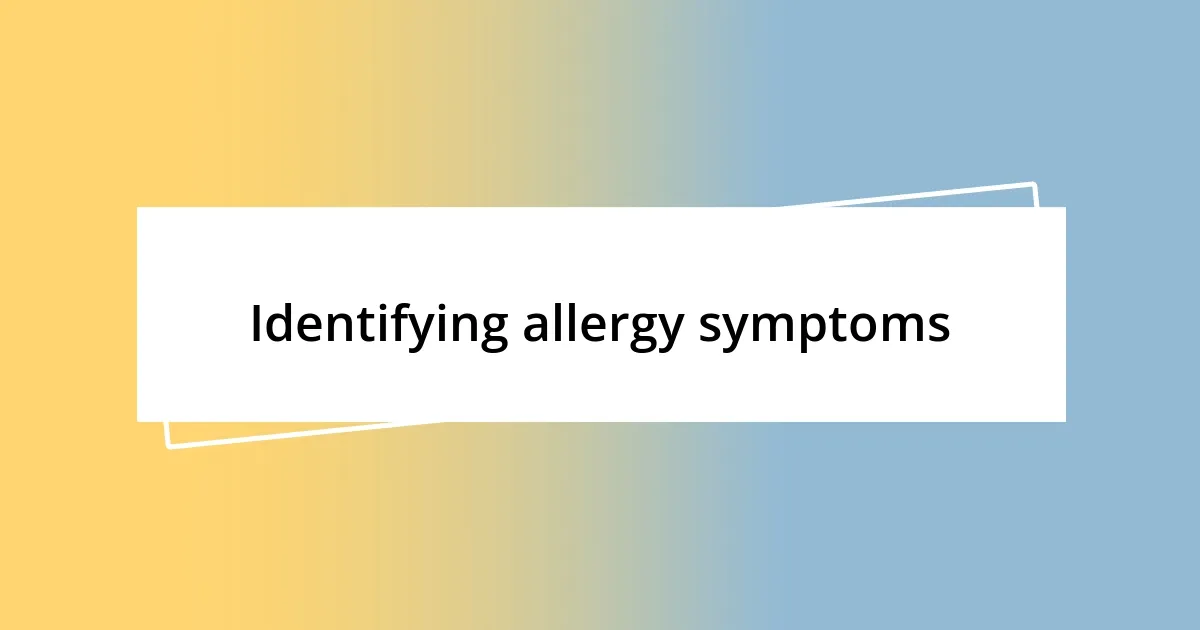
Identifying allergy symptoms
Identifying allergy symptoms can sometimes feel like deciphering a secret code. I remember sitting on the couch with Whiskers, feeling that familiar tickle in my throat while my eyes started watering uncontrollably. At first, I brushed it off as a common cold, but it lingered, reminding me that something was off. It was during those moments that I realized I needed to pay more attention to my body’s signals.
Some common symptoms to watch for include:
- Sneezing and nasal congestion
- Itchy or watery eyes
- Coughing or wheezing
- Skin rashes or hives
- Shortness of breath
The tricky part about these symptoms is they can easily be mistaken for seasonal allergies or a minor cold. I learned to keep a close eye on when and where these symptoms flared up. After a particularly intense week with Whiskers, I started to connect the dots and recognize the patterns. It was a wake-up call that pushed me to slowly reevaluate my living space while still cherishing my furry friend.
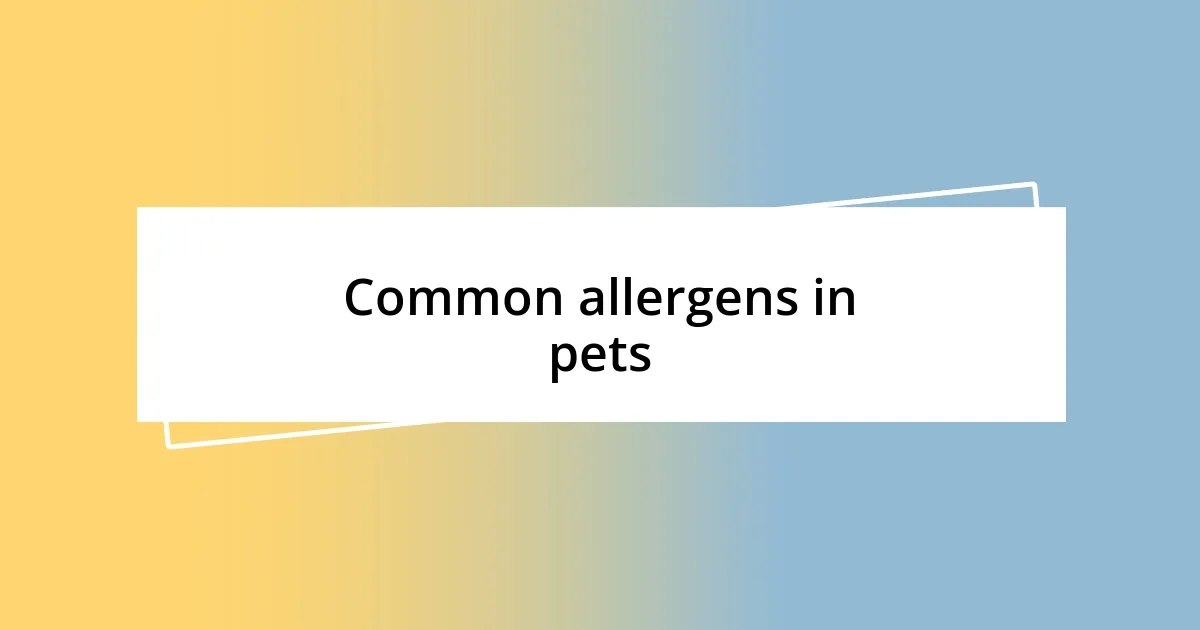
Common allergens in pets
The most common allergens in pets typically come from proteins found in their saliva, urine, and dander. It took me a while to understand that when my dog, Max, licked my face, I wasn’t just being showered with affection; I was also possibly inviting in allergens that could trigger my allergies. Recognizing these allergens has made me more mindful of how I interact with my furry friends, and sometimes, it’s all about finding that perfect balance between love and comfort.
Another surprising allergen is pet dander. It’s microscopic and can settle on just about everything—from furniture to clothing. When I noticed my allergies spike after a rainy day when Max splashed around outside, it clicked; wet fur releases more dander into the air. This experience made me realize how vital it is to keep clean and manage my surroundings, particularly when it relates to baring the brunt of allergens while wanting to snuggle with him.
Interestingly, some pets can also have specific food allergies that can lead to skin irritations or other allergic reactions. I once fed Max a new treat, thinking I was being kind, but found out he was allergic to a certain ingredient. Watching him scratch furiously was heartbreaking and it highlighted the importance of understanding not just common allergens, but also those hidden triggers lurking in food.
| Common Pet Allergens | Description |
|---|---|
| Saliva | Proteins in saliva can cause reactions when pets groom themselves and lick surfaces. |
| Dander | Microscopic skin flakes that can aggravate allergies when they become airborne. |
| Urine | Proteins in urine can linger in the home and contribute to allergic reactions. |
| Food Allergens | Specific ingredients that pets may be allergic to, leading to various skin and stomach issues. |

Steps to reduce exposure
Creating a pet-friendly environment while managing allergies is often about small, intentional changes. I remember installing air purifiers throughout my home, particularly in the rooms where I spent the most time. Simply breathing that cleaner air felt like an immediate relief, like finally exhaling after holding my breath too long. Why hadn’t I thought of this sooner? It’s such a straightforward step that can significantly lower allergen levels.
Another vital step involved setting boundaries with my pets. Initially, having Whiskers on the couch was a non-negotiable, but I soon realized that it was also a trigger for my allergies. I started designating pet-free zones, particularly my bedroom. The first few nights felt strange, but over time, it became refreshing to have a dedicated space where allergies could take a back seat. Isn’t it amazing how establishing a little distance can enhance our quality of life?
Frequently washing my hands after petting them was another game-changer. I can’t tell you how many times I’d absentmindedly rubbed my eyes only to be reminded of that fur-covered embrace. By making it a habit to wash up after cuddling, I noticed a marked decrease in flare-ups. It may sound simple, but those little practices accumulate and genuinely transform daily comfort. Isn’t it incredible how such small steps can lead to a more harmonious life with our furry friends?
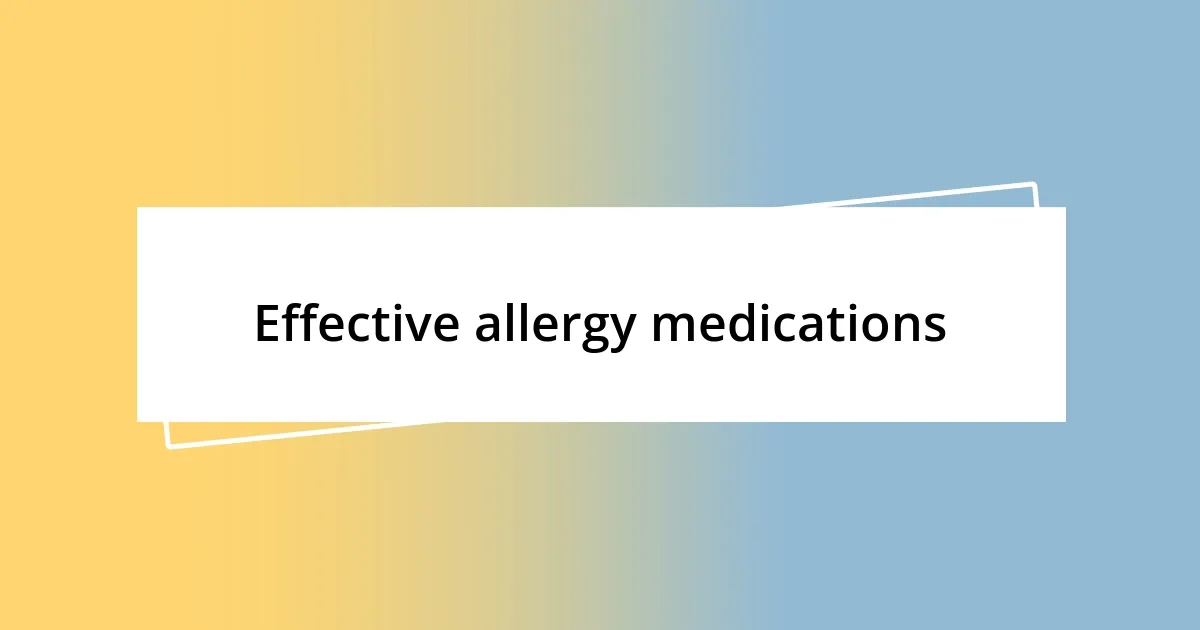
Effective allergy medications
After dealing with my allergies, I discovered that effective medications played a crucial role in my comfort. Antihistamines became my best friends; they work by blocking the histamines that trigger those annoying allergy symptoms. I still remember the first time I took one—relief washed over me like a cool breeze on a hot day. Why did it take me so long to figure this out?
Nasal corticosteroids were another game-changer for me. They reduce inflammation in the nasal passages, and I found that using a nasal spray daily made a noticeable difference. I vividly recall sneezing uncontrollably in a park, then feeling like I’d uncovered a magic solution once I started using it consistently. Isn’t it fascinating how a small act can lead to such freedom?
In addition, my doctor recommended leukotriene inhibitors, which target a different path in allergic reactions. I was skeptical at first, thinking I could manage with just antihistamines, but it turned out they were a fantastic complement. Once I added them to my regimen, I noticed fewer allergy days. Finding the right combination of medications can feel like an endless puzzle, but trust me, the relief is worth the search.

Alternative pet ownership solutions
Finding alternative pet ownership solutions was a journey of exploration for me. One day, I stumbled upon the idea of hypoallergenic pets. It sounded too good to be true, but I did my research and discovered breeds like Poodles and Bichon Frises are often better suited for allergy sufferers. Although they still require grooming, the thought of having a furry friend who causes fewer allergies felt like a breath of fresh air. Have you ever considered how a breed change could transform your experience with pets?
Another approach I took was fostering. When I learned that fostering pets could offer companionship without the long-term commitment, it was like a light bulb moment. I could help animals in need while also giving myself a space where I could step back if my allergies flared up. This solution allowed me to experience the joy of pet ownership temporarily, and honestly, the sense of purpose that came with it was rewarding. Have you felt that rush of joy when you make a positive impact in someone else’s life?
Additionally, I explored pet-sharing options with friends and family. It was a delightful surprise to find that by coordinating pet playdates with others, I could enjoy spending time with animals without the burden of everyday care. This flexibility allowed me to relish those joyful moments without the allergy-associated tension at home. Isn’t it satisfying to find creative solutions that feel like a win-win for everyone involved?

Long-term management strategies
Maintaining a clean living environment was essential in my long-term management strategy. I invested in a high-efficiency particulate air (HEPA) filter for my home, which dramatically improved my air quality. The first time I noticed a significant reduction in my symptoms after I set it up felt like a small victory—one that encouraged me to keep my space as allergen-free as possible. Have you ever seen how just a few changes can breathe new life into your home?
Furthermore, regular cleaning became a non-negotiable part of my routine. I started vacuuming and dusting more frequently, especially focusing on areas where pet dander tends to hide. The sense of relief I felt each time I finished cleaning—knowing I was taking control of my environment—was empowering. It also inspired me to incorporate deep-cleaning days into my schedule; have you considered how these small efforts can lead to significant differences in your allergy management?
Lastly, I made sure to establish an allergy-friendly space in my home. This meant creating zones where my pets were not allowed, which helped me carve out safe havens to retreat to when symptoms flared. It was surprisingly satisfying to have a designated area that felt like an oasis. Have you thought about how personalizing your space can help you manage your allergies while still enjoying your pet’s company?












